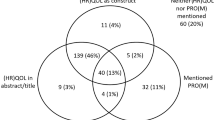Abstract
Health-related quality of life (HRQL) instruments have been used to measure HRQL in heart failure patients, but how different instruments compare in the same groups of patients is not known. The purpose of this study was to compare the reliability and validity of three HRQL measures in 211 heart failure patients recruited from clinics affiliated with an urban hospital. Two disease-specific instruments, the chronic heart failure questionnaire (CHQ) and the living with heart failure questionnaire (LHFQ), and one generic instrument, the short-form 12 (SF-12), were administered. Patients reported moderate to low HRQL scores. Floor or ceiling effects were noted in the disease-specific instruments. Internal consistency reliabilities of the CHQ and LHFQ were satisfactory. Construct, convergent, and discriminant validity were supported for each instrument. Each scale and subscale, except for the SF-12 mental component scale, differentiated between patients with New York Heart Association (NYHA) class I, II, and III plus IV; the LHFQ physical subscale was the only measure to differentiate between patients with NYHA class III and IV. All three instruments were satisfactory for measuring HRQL, but the disease-specific instruments were preferable to the generic instrument. The decision of which instrument to use depends on the purpose of the study.
Similar content being viewed by others
References
Cohn JN. Physiological variables as markers for symptoms, risk, and interventions in heart failure. Circulation 1993; 87 (Suppl VII) VII-110-VII-114.
Wilson IB, Cleary PD. Linking clinical variables with health-related quality of life. JAMA 1995; 273: 59–65.
Testa MA, Simonson DC. Assessment of quality-of-life outcomes. N Engl J Med 1996; 334: 835–840.
Rector TS, Francis GS, Cohn JN. Patients' self-assessment of their congestive heart failure, Part 1: Patient perceived dysfunction and its poor correlation with maximal exercise tests. Heart Failure 1987; 3: 192–196.
Rector TS, Kubo SH, Cohn JN. Patients' self-assessment of their congestive heart failure, Part 2: Content, reliability and validity of a new measure, the Minnesota living with heart failure questionnaire. Heart Failure 1987; 3: 198–209.
Guyatt GH, Nogradi S, Halcrow S, et al. Development and testing of a new measure of health status for clinical trials in heart failure. J Gen Intern Med 1989; 4: 101–107.
Guyatt GH, Sullivan MJJ, Fallen E, et al. A controlled trial of digoxin in congestive heart failure. Am J Cardiol 1988; 61: 371–375.
Ware JE, Kosinski M, Keller SD. SF-12: How to score the SF-12 Physical and Mental Health Summary Scales. 2nd ed. Boston: The Health Institute, New England Medical Center, 1995.
Ware JE, Kosinski M, Keller SD. A 12-item short-form health survey (SF-12): construction of scales and preliminary tests of reliability and validity. Med Care 1996; 32: 220–233.
Rector TS, Cohn JN. Assessment of patient outcome with the Minnesota living with heart failure questionnaire: Reliability and validity during a randomized, double-blind, placebo-controlled trial of pimobendan. Am Heart J 1992; 124: 1017–1025.
Rector TS, Kubo SH, Cohn JN. Validity of the Minnesota living with heart failure questionnaire as a measure of therapeutic response to Enalapril or placebo. Am J Cardiol 1993; 71: 1106–1108.
Lee DC, Johnson RA, Bingham JB, et al. Heart failure in outpatients: A randomized trial of digoxin versus placebo. N Engl J Med 1982; 306: 699–705.
Wolinsky FD, Wyrwich KW, Nienaber NA, Tierney WM. Generic versus disease-specific health status measures. Eval the Health Prof 1998; 21: 216–243.
Wyrwich KW, Nienaber NA, Tierney WM, Wolinsky FD. Linking clinical relevance and statistical significance in evaluating inter-individual changes in health-related quality of life. Med Care 1999; 37: 469–478.
Ware JE, Kosinski M, Keller SD. SF-36 physical and mental health summary scales: A user's manual. Boston: The Health Institute, New England Medical Center, 1994.
Braunwald E. Heart Disease: A Textbook of Cardiovascular Medicine. 4th ed. Philadelphia: W.B. Saunders, 1992.
Pfeiffer E. A short portable mental status questionnaire for the assessment of organic brain deficit in elderly patients. JAGS 1975; 23: 433–441.
Gallo JJ, Reichel W, Andersen LM. Handbook of Geriatric Assessment. 2nd ed. Gaithersburg, MD: Aspen, 1995.
McDonald CJ, Tierney WM, Martin D, Overhage JM. Regenstrief Medical Record System: 20 years' experience in hospital outpatient clinics and neighborhood health centers. MD Comput 1992; 9: 206–217.
Tierney WM, Miller ME, Hui SL, McDonald CJ. Practice randomization and clinical research: The Indiana experience. Med Care 1991; 29: JS57-JS64.
New York Heart Association Criteria Committee. Diseases of the Heart and Blood Vessels: Nomenclature and Criteria for Diagnosis. 6th ed. Boston: Little, Brown & Co, 1964.
Nunnelee JD. The inclusion of women in clinical trials of antihypertensive medications: A review of twenty-four trials in one pharmacology journal. Vasc Nurs 1995; 13: 41–49.
Kelly PJ, Cordell JR. Recruitment of women into research studies: A nursing perspective. Clin Nurse Spec 1996; 10: 20.
Konstam MA. Progress in heart failure management?: Lessons from the real world. Circulation 2000; 102: 1076–1078.
Landis JR, Koch GG. The measurement of observer agreement for categorical data. Biometrics 1977; 33: 159–174.
SAS Computer Program, Version 8. SAS Institute Inc. Cary, NC. 1999–2000.
Nunnally J. Psychometric Theory. NY: McGraw-Hill, 1978.
Gorsuch RL. Factor Analysis. 2nd ed. Hillsdale, NJ: Lawrence Erlbaum Associates, 1983.
Ni H, Toy W, Burgess D, et al. Comparative responsiveness of short-form 12 and Minnesota living with heart failure questionnaire in patients with heart failure. J Cardiac Failure 2000; 6: 83–91.
Bennett SJ, Cordes DK, Westmoreland GR, Castro R, Donnelly E. Self-care strategies for symptom management in patients with chronic heart failure. Nurs Res 2000; 49: 139–145.
Califf RM, Vidaillet H, Goldman L. Advanced congestive heart failure: What do patients want? Am Heart J 1998; 135: S320-S326.
Author information
Authors and Affiliations
Corresponding author
Rights and permissions
About this article
Cite this article
Bennett, S.J., Oldridge, N.B., Eckert, G.J. et al. Discriminant properties of commonly used quality of life measures in heart failure. Qual Life Res 11, 349–359 (2002). https://doi.org/10.1023/A:1015547713061
Issue Date:
DOI: https://doi.org/10.1023/A:1015547713061




